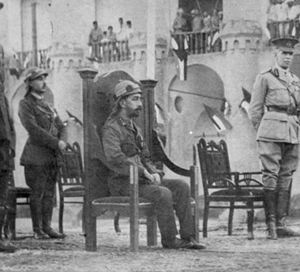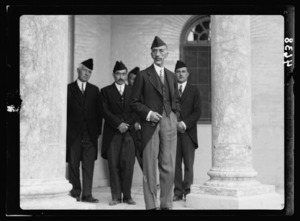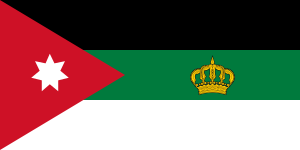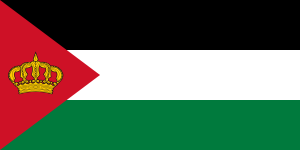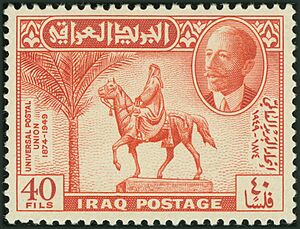Faisal I of Iraq facts for kids
Quick facts for kids Faisal Iفيصل الأول |
|||||
|---|---|---|---|---|---|
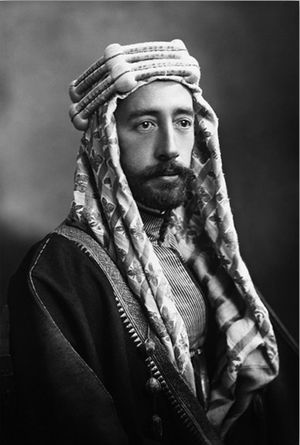 |
|||||
| King of Iraq | |||||
| Reign | 23 August 1921 – 8 September 1933 | ||||
| Predecessor | Military occupation | ||||
| Successor | Ghazi I | ||||
| Prime Ministers |
See list
Abd Al-Rahman Al-Gillani
Abd al-Muhsin as-Sa'dun Jafar al-Askari Yasin al-Hashimi Tawfiq al-Suwaidi Naji al-Suwaidi Nuri al-Said Naji Shawkat Rashid Ali al-Gaylani |
||||
| King of Syria | |||||
| Reign | 8 March 1920 – 24 July 1920 | ||||
| Predecessor | Military occupation | ||||
| Successor | Monarchy abolished | ||||
| Prime Ministers |
See list
Rida Pasha al-Rikabi
Hashim al-Atassi |
||||
| Born | 20 May 1885 Mecca, Hejaz Vilayet, Ottoman Empire |
||||
| Died | 8 September 1933 (aged 48) Bern, Switzerland |
||||
| Burial | Royal Mausoleum, Adhamiyah | ||||
| Spouse | Huzaima bint Nasser | ||||
| Issue |
|
||||
|
|||||
| House | Hashemite | ||||
| Father | Hussein bin Ali, King of Hejaz | ||||
| Mother | Abdiyah bint Abdullah | ||||
| Religion | Sunni Islam | ||||
Faisal I bin Al-Hussein bin Ali Al-Hashemi (Arabic: فيصل الأول بن الحسين بن علي الهاشمي; 20 May 1885 – 8 September 1933) was an important Arab leader. He was the King of the Arab Kingdom of Syria in 1920. Later, he became the first King of Iraq from 1921 until his death.
Faisal was the third son of Hussein bin Ali. His father was the Grand Emir and Sharif of Mecca. Faisal belonged to the Hashemite family. This means he was a direct descendant of the Islamic prophet Muhammad.
King Faisal wanted to unite different groups in his country. He worked to bring together Sunni and Shiite Muslims. His goal was to create a strong Arab state. This state would include Iraq, Syria, and other nearby lands. He also tried to include different ethnic and religious groups in his government.
Contents
Early Life and Beginnings
Faisal was born in Mecca in 1885. At that time, Mecca was part of the Ottoman Empire. Today, it is in Saudi Arabia. He grew up in Istanbul and learned leadership skills from his father.
In 1913, Faisal was chosen as a representative for the city of Jeddah. He served in the Ottoman parliament. This was his first step into politics.
Meeting Arab Secret Societies
In 1914, the Ottoman Empire went to war. Faisal's father sent him to discuss Arab involvement. On his journey, Faisal visited Damascus. There, he met with secret Arab groups. These groups wanted Arab independence. Faisal joined the Al-Fatat group of Arab nationalists.
World War I and the Arab Revolt
During World War I, Faisal played a key role. He met Captain T. E. Lawrence in 1916. Lawrence was a British intelligence officer. He believed Faisal was the right person to lead the Arab forces.
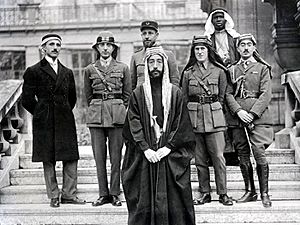
Leading the Northern Army
From 1916 to 1918, Faisal led the Northern Army of the Arab Revolt. This revolt fought against the Ottoman Empire. His forces operated in areas that are now Saudi Arabia, Jordan, and Syria.
Faisal worked with the Allies during the war. He helped them conquer Greater Syria. His forces also captured Damascus in October 1918. After this victory, Faisal became part of a new Arab government in Damascus.
After World War I
After the war, Faisal became an important voice for Arabs.
Paris Peace Conference
In 1919, Emir Faisal led the Arab group to the Paris Peace Conference. He asked for independent Arab states. These states would be in the areas that the Ottoman Empire used to control. He had support from Gertrude Bell, a British expert.
The Idea of Greater Syria
British and Arab forces took Damascus in October 1918. Faisal then helped set up an Arab government in Greater Syria. This government was under British protection. In 1919, elections were held for the Syrian National Congress.
Faisal–Weizmann Agreement
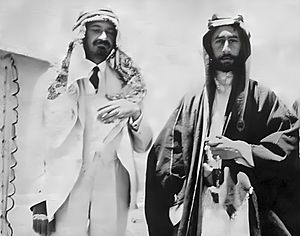
On January 4, 1919, Faisal signed an agreement with Dr. Chaim Weizmann. Weizmann was the head of the World Zionist Organization. This agreement was for Arab-Jewish cooperation. Faisal agreed to the Balfour Declaration. This declaration promised British support for a Jewish homeland in Palestine.
Faisal hoped that Zionist influence would help prevent France from taking over Syria. However, this partnership did not work out. Faisal could not get much support from Arab leaders for a Jewish homeland.
King of Syria and Iraq
On March 7, 1920, Faisal was declared King of the Arab Kingdom of Syria. This was done by the Syrian National Congress.
Expelled from Syria
In April 1920, France was given control over Syria. This led to the Franco-Syrian War. In the Battle of Maysalun on July 24, 1920, the French won. Faisal was then forced to leave Syria.
Becoming King of Iraq
In March 1921, British officials met at the Cairo Conference. They decided Faisal would be a good choice to rule the new British Mandate of Iraq. This was because he seemed willing to work with powerful nations.
At first, many people in Iraq did not know Faisal. With help from British officials like Gertrude Bell, he gained support. He campaigned among the Arabs of Iraq. A vote was held, and 96% of people supported him.
On August 23, 1921, Faisal became the first King of Iraq. Iraq was a new country. It was formed from three former Ottoman provinces: Mosul, Baghdad, and Basra. At that time, there was no strong sense of Iraqi national identity.
Faisal's Goals as King
As King, Faisal wanted to promote pan-Arab nationalism. This idea aimed to unite Arab countries. He hoped to bring Syria, Lebanon, and Palestine under his rule. This would make the Sunni Arabs the majority in his kingdom.
Faisal also wanted to improve education in Iraq. He hired doctors and teachers for the government. He brought in Sati' al-Husri, a former Minister of Education from Damascus. This led to some local people feeling upset about the number of Syrians in Iraq.
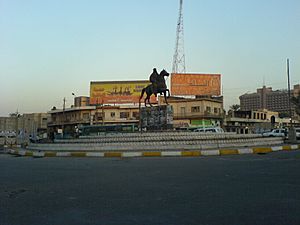
Faisal was a fair leader. He said he was a friend to the Shiite, Kurdish, and Jewish communities. He tried to stop his ministers from firing Jewish Iraqis from government jobs. However, his focus on pan-Arabism sometimes caused problems. It made Kurds feel like they did not belong in an Arab-dominated Iraq.
He also worked to develop roads from Baghdad to Damascus and Amman. This helped Iraq's economy. It also increased interest in the Mosul oilfield. Faisal planned to build an oil pipeline to the Mediterranean Sea.
Building the Iraqi Army
King Faisal worked hard to build a strong Iraqi army. He tried to make military service required for everyone. This plan did not succeed. Some people believe this was part of his larger goal to unite Arab lands.
Relations with Syria and Palestine
During the Great Syrian Revolt against French rule, Faisal was careful. He did not strongly support the rebels. This was partly due to British pressure. Also, he thought the French might let a Hashemite ruler govern Syria again. The French did talk to Faisal about Syria. But they were just trying to stop him from helping the rebels.
In 1929, there were conflicts in Jerusalem between Arabs and Jews. Faisal supported the Arab side. He asked the British to limit Jewish immigration and land purchases in Palestine. He suggested that Palestine become independent and join a federation. This federation would be led by his brother, Emir Abdullah of Trans-Jordan.
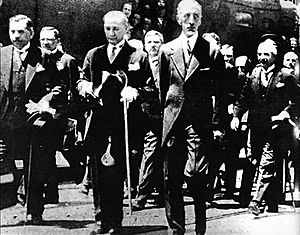
Faisal saw the Anglo-Iraqi Treaty of 1930 as a problem. This treaty gave Iraq some independence. But it also kept Syria and Iraq separate. This went against his goal of Arab unity. Even so, many Arab nationalists in Iraq liked the treaty. They saw it as progress for their country.
Iraq's Independence
In 1932, the British mandate over Iraq ended. Faisal was very important in making Iraq an independent country. On October 3, the Kingdom of Iraq joined the League of Nations.
In August 1933, there were tensions between the United Kingdom and Iraq. This was due to incidents like the Simele massacre. British officials asked Faisal to stay in Baghdad to deal with the situation. Faisal assured them that things were calm.
Just before his death in July 1933, Faisal visited London. He expressed his worries about the situation of Arabs. He was concerned about the conflict with Jews and increased Jewish immigration to Palestine. He asked the British to limit Jewish immigration and land purchases.
Death of King Faisal I
King Faisal died from a heart attack on September 8, 1933. He was in Bern, Switzerland, and was 48 years old. His oldest son, Ghazi, became the next King of Iraq.
A square in Baghdad is named after him. It has a statue of him on horseback. The statue was taken down after the monarchy was overthrown in 1958. But it was later put back up.
Family Life
Faisal was married to Huzaima bint Nasser. They had one son and three daughters:
- Princess Azza bint Faisal.
- Princess Rajiha bint Faisal.
- Princess Raifia bint Faisal.
- Ghazi, King of Iraq, born in 1912. He married his cousin, Princess Aliya bint Ali.
Faisal in Films
Faisal has been shown in movies several times:
- In Lawrence of Arabia (1962), played by Alec Guinness.
- In A Dangerous Man: Lawrence After Arabia (1990), played by Alexander Siddig.
- In Queen of the Desert (2015), played by Younes Bouab.
- In The Adventures of Young Indiana Jones: Chapter 19 The Winds of Change (1995), played by Anthony Zaki.
Images for kids
See also
 In Spanish: Fáysal I de Irak para niños
In Spanish: Fáysal I de Irak para niños
- Faisal–Weizmann Agreement
- List of Syrian monarchs
- Timeline of Syrian history
- Battle of Maysalun
- Ali of Hejaz
- Abdullah I of Jordan
- Ghazi of Iraq
- Hussein of Hejaz


